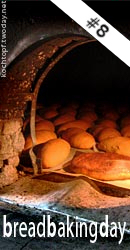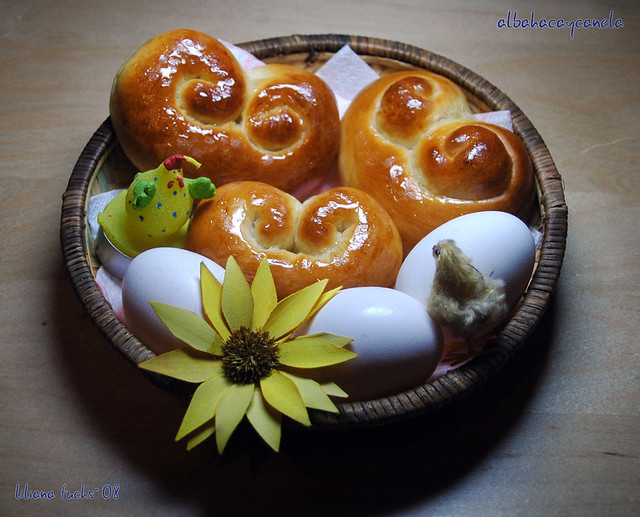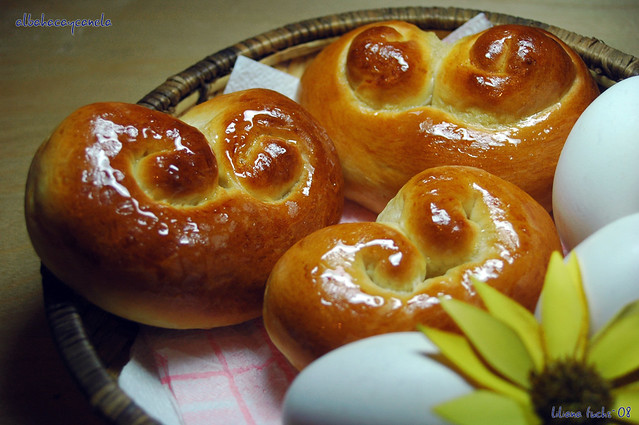[Entry for BreadBakingDay #8 - English version below]
Mi hermano el suertudo estuvo hace poco una semana de viaje por Centroeuropa, pasando por
 Praga, lo que me ha recordado que tengo pendientes varias entradas y subida de fotos de mi viaje del verano... aarg, qué cabeza tengo; claro, lo fui posponiendo y... bueno, a ver si aprovecho este par de semanitas de vacaciones. Para redimirme, ayer probé otra receta del libro de cocina checa que compré en la capital checa. Por supuesto, lo abrí por la sección dulce :P
Praga, lo que me ha recordado que tengo pendientes varias entradas y subida de fotos de mi viaje del verano... aarg, qué cabeza tengo; claro, lo fui posponiendo y... bueno, a ver si aprovecho este par de semanitas de vacaciones. Para redimirme, ayer probé otra receta del libro de cocina checa que compré en la capital checa. Por supuesto, lo abrí por la sección dulce :PYo la verdad es que nunca he celebrado una Semana Santa muy a la española, no he ido a ninguna procesión (y anda que en Murcia hay pocas) y tampoco seguimos la gastronomía típica. Cuando era pequeña solían venir mis abuelos de Suiza y teníamos unas Pascuas dulces, decorando huevos, escondiendo chocolates por el jardín...
Con estos bollos de Pascua participo por primera vez en el Bread Bakind Day que gestiona este mes el blog Wild Yeast, dedicado a panes de celebración. Me he dado cuenta de la oxidación que sufre mi inglés...
En la República Checa se celebra (o era tradición celebrar) especialmente el Domingo de Pascua con abundantes comidas familiares: cordero asado, carne de vacuno, puding de huevo, carne ahumada y muchos platos con vegetales verdes y hierbas. Se solían cocer las hojas frescas de ortiga como si fueran espinacas, y hacer ensaladas con diente de león. En cuanto a dulces, destaca el cordero de pascua, un pan dulce con forma de cordero que se puede decorar con con merengue o chocolate, y una trenza roja. También están los boží milosti (mercedes de Dios, fritos y espolvoreados con azúcar) y mazanec (otro pan dulce).
Según el libro, en Viernes Santo los checos hornean bollos de Pascua enrollados, que se suelen servir como almuerzo de Cuaresma o como dulce acompañando el café. Por lo que he podido leer, estos bollos se llaman jidášky, panecillos de Judas, simbolizando la cuerda del ahorcamiento; no estoy del todo segura de si son el mismo bollo o dos tipos distintos.
En cualquier caso la receta ha salido más que bien, no es muy difícil ni laboriosa, aparte de los tiempos de levado. Salen unos bollos muy muy tiernos, nada empalagosos ya que llevan poco azúcar, estupendos solos, con café/té/chocolate, tal cuales o untados con mermelada/mantequilla/miel...

- 400 gr de harina normal o medio fuerte*
- harina extra para amasar**
- 30 gr de levadura fresca
- 40 gr de azúcar fino
- 250 ml de leche tibia
- una pizca de sal
- 60 gr de mantequilla muy blanda
- 2 yemas de huevo
- 1 huevo batido para pintar
- miel disuelta en un poco de agua
* yo usé 300 gr de harina de fuerza que tenía en un paquete abierto y 100 gr normal
* * después de poner toda la harina de la receta necesité añadir una cantidad considerable (a ojo y muy poco a poco para poder tener una masa mínimamente manejable.
En un bol amplio tamizar la harina y hacer una especie de volcán. Trocear la levadura y colocarla en ese hoyo central, añadir el azúcar y un par de cucharadas de leche. Remover, añadiéndole un poco de la harina, tapar con un paño y dejar unos 15-20 minutos para que fermente.
Después se incorporan poco a poco el resto de ingredientes, poniendo primero la sal en la harina (nunca directamente sobre la levadura), mezclando bien hasta formar una masa homogénea. Como he señalado arriba, me salió muy pegajosa así que fui añadiendo más harina hasta que se podía amasar. La masa debe quedar manejable, pero aún así pegajosa, no seca. Con las manos enharinadas, amasar unos minutos (va muy bien usar una lámina de silicona para evitar que se pegue; si no simplemente espolvorear una superficie con algo de harina). Cuando la masa esté elástica, se pone en un bol, se cubre con papel film y/o unos paños y se deja levar en un lugar cálido sin corrientes.

Czech Easter BunsThis is my first entry for zorra's Bread Baking Day hosted this month by Wild Yeast. I'm from Murcia (Spain) and I have not practiced English for a long time; sorry for that!
This recipe comes from a little book I bought last summer in Prague: Czech Cookery. I don't like very much spanish Easter recipes, so I decided to try this traditional Easter Buns. Acording to the book, on Good Friday Czechs bake this buns and serve them with coffee or tea as a Lenten lunch. They turned out great and tasted wonderfull with some jam.
- 300 gr fine or medium flour
- extra flour for rolling
- 30 gr fresh yeast
- 40 gr castor or icing sugar
- 250 ml warm milk
- a pinch of salt
- 60 gr melted butter
- 2 yolks eggs
- 1 beaten egg
- honey
Sift the flour into a bowl and make a hole. Crumble the yeast into it, add the sugar and two tablespoons of milk. Mix into a paste adding some of the flour. Cover and leave to rise abour 15-20 min.
Add the salt to the flour. Work the mixture adding the melted butter, egg yolks and the remaining milk. If the dough is too sticky, add more flour gradually to get a manageable mixture. Dust with some flour a clean surface and knead by hand for about 8-10 min, until the dough is firm and elastic. Cover and leave to rise in a warm place.
When it has double the size (abour 2 hours) place the risen dough on a board and work it smooth. Cut pieces and roll them into your favourite shape. Arrange the buns on a backing sheet and leave them to rise for 5 min. Prehate the oven to 200º. Brush the buns with beaten egg and bake them until golden (down the temperature to 180º after 5 minutes). Be careful, if the buns are too small they can get too roasted shortly. When the buns have cooled, dribble honey on them.

This recipe comes from a little book I bought last summer in Prague: Czech Cookery. I don't like very much spanish Easter recipes, so I decided to try this traditional Easter Buns. Acording to the book, on Good Friday Czechs bake this buns and serve them with coffee or tea as a Lenten lunch. They turned out great and tasted wonderfull with some jam.
- 300 gr fine or medium flour
- extra flour for rolling
- 30 gr fresh yeast
- 40 gr castor or icing sugar
- 250 ml warm milk
- a pinch of salt
- 60 gr melted butter
- 2 yolks eggs
- 1 beaten egg
- honey
Sift the flour into a bowl and make a hole. Crumble the yeast into it, add the sugar and two tablespoons of milk. Mix into a paste adding some of the flour. Cover and leave to rise abour 15-20 min.
Add the salt to the flour. Work the mixture adding the melted butter, egg yolks and the remaining milk. If the dough is too sticky, add more flour gradually to get a manageable mixture. Dust with some flour a clean surface and knead by hand for about 8-10 min, until the dough is firm and elastic. Cover and leave to rise in a warm place.
When it has double the size (abour 2 hours) place the risen dough on a board and work it smooth. Cut pieces and roll them into your favourite shape. Arrange the buns on a backing sheet and leave them to rise for 5 min. Prehate the oven to 200º. Brush the buns with beaten egg and bake them until golden (down the temperature to 180º after 5 minutes). Be careful, if the buns are too small they can get too roasted shortly. When the buns have cooled, dribble honey on them.







Los bollos son muy hermosos y me parecen delciosos!
ResponderEliminarMuchas gracias por tu participación en BreadBakingDay.
Estupendos bollos Akane!!!
ResponderEliminarCaray!! eres una artista! Un saludo
ResponderEliminarHola Akane, esos bollos tiene un aspecto espectacular!!! Mein Gott! Voy a ver si me salen tan bien, estoy pensando en especialidades para la "pascua dulce" (también en Alemania, claro). Un abrazo, :-D
ResponderEliminarQué ricos! Saben parecido a los bollos de leche de toda la vida?
ResponderEliminarsaluditos!
que buenisimos bollos. Me encantan porque además no deben ser muy dulces ¿verdad?
ResponderEliminarLA OTRA
¡Qué maravilla de bollos! Te han quedado de pastelería. A ver si me animo y te los copio ;))
ResponderEliminarFelicidades por tu blog. Saludos.
canela
Susan
ResponderEliminarMuchas gracias a ti por acoger el BBD esta vez! Tu blog es genial :D
salvia
Muchísimas gracias :)
Anxos
Qué vaa, algunos se me rebelaron y no salieron muy fotogénicos; pero igual de comestibles :P Gracias por el comentario ^^
Lillu
La verdad es que sí, se parecen bastante en sabor y textura (sobretodo a unos que le compra mi madre a mi hermano), aunque también se asemejan algo a las monas de Pascua (al menos a las que hacen por aquí).
LA UNA Y LA OTRA
Exacto, son muy poco dulces, eso también me gusta a mí; así se pueden tomar con lo que se quiera, dulce o salado.
canela
Si te animas con la receta o a versionarla espero ver los resultados en tu blog :)
Gracias por tu visita!
nek0
Como te he dicho en tu blog, muchas muchas asias!!
Saludos a todos!
How beautiful!
ResponderEliminarQué rico! félicidades! quiero comerlos pronto!
ResponderEliminarestos panecillos son preciosos!!! y seguro que están buenísismos!!!
ResponderEliminarbs!
Ma Petite Boulangerie